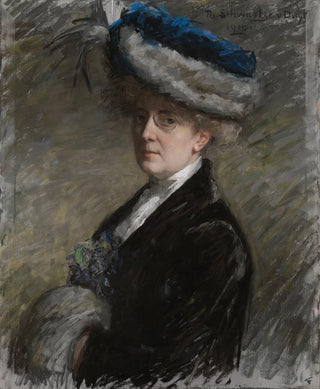Art print | Self-portrait - Thérèse Schwartze


View from behind

Frame (optional)
Reproduction Autoportrait - Thérèse Schwartze – Captivating Introduction
The artwork "Autoportrait" by Thérèse Schwartze presents itself as an open window into the soul of an artist with a unique journey. This canvas, created at the end of the 19th century, embodies not only the technical mastery of its creator but also a pivotal moment in Dutch art history. By depicting herself, Schwartze does not merely reveal her physical appearance; she invites the viewer to delve into her inner universe, to explore the emotions and reflections that inhabit her. The art print of this self-portrait offers a unique opportunity to contemplate a work that transcends mere stylistic exercise to become a true testament to the female condition at a time when women artists struggled to find their place.
Style and uniqueness of the work
Thérèse Schwartze's style is distinguished by a delicate approach to portraiture, where light and shadows play a predominant role. In "Autoportrait," she uses warm tones and subtle nuances to create an intimate atmosphere. The details of her face, the texture of her hair, and the sparkle in her eyes demonstrate meticulous attention to the representation of personality. What also strikes in this work is the artist's posture, which appears both confident and introspective. The composition, well balanced, draws the eye toward her face while hinting at elements of her environment, thus suggesting a rich and complex life. This blend of realism and sensitivity gives the work emotional depth that still resonates today.
The artist and her influence
Thérèse Schwartze, born in 1851, is an iconic figure in Dutch art, known for her commitment to representing women in painting. At a time when society valued women's work little, she managed to establish herself through her talent and determination. Her work was praised by her contemporaries, and she was even the first woman to be elected a member of the Royal Academy of Arts of the Netherlands. Schwartze played a crucial role in the evolution of female portraiture, highlighting models that reflect the diversity of experiences

Matte finish

View from behind

Frame (optional)
Reproduction Autoportrait - Thérèse Schwartze – Captivating Introduction
The artwork "Autoportrait" by Thérèse Schwartze presents itself as an open window into the soul of an artist with a unique journey. This canvas, created at the end of the 19th century, embodies not only the technical mastery of its creator but also a pivotal moment in Dutch art history. By depicting herself, Schwartze does not merely reveal her physical appearance; she invites the viewer to delve into her inner universe, to explore the emotions and reflections that inhabit her. The art print of this self-portrait offers a unique opportunity to contemplate a work that transcends mere stylistic exercise to become a true testament to the female condition at a time when women artists struggled to find their place.
Style and uniqueness of the work
Thérèse Schwartze's style is distinguished by a delicate approach to portraiture, where light and shadows play a predominant role. In "Autoportrait," she uses warm tones and subtle nuances to create an intimate atmosphere. The details of her face, the texture of her hair, and the sparkle in her eyes demonstrate meticulous attention to the representation of personality. What also strikes in this work is the artist's posture, which appears both confident and introspective. The composition, well balanced, draws the eye toward her face while hinting at elements of her environment, thus suggesting a rich and complex life. This blend of realism and sensitivity gives the work emotional depth that still resonates today.
The artist and her influence
Thérèse Schwartze, born in 1851, is an iconic figure in Dutch art, known for her commitment to representing women in painting. At a time when society valued women's work little, she managed to establish herself through her talent and determination. Her work was praised by her contemporaries, and she was even the first woman to be elected a member of the Royal Academy of Arts of the Netherlands. Schwartze played a crucial role in the evolution of female portraiture, highlighting models that reflect the diversity of experiences






